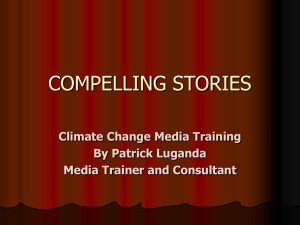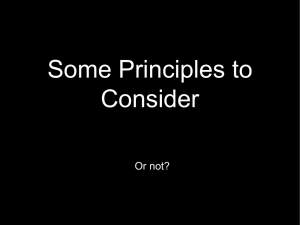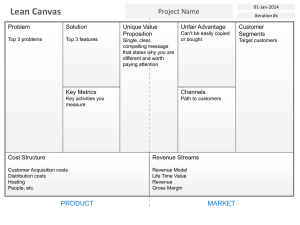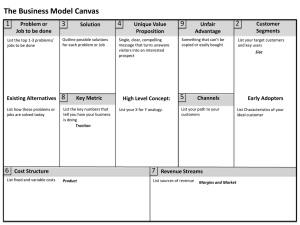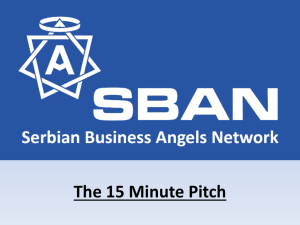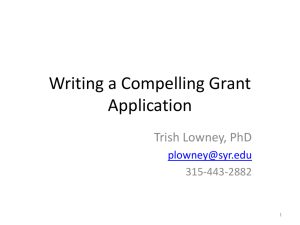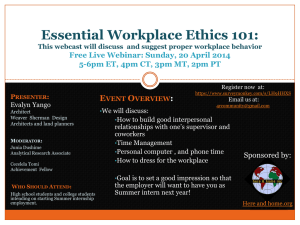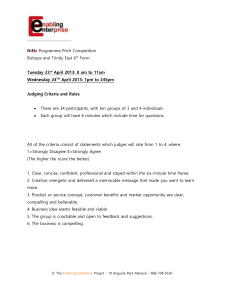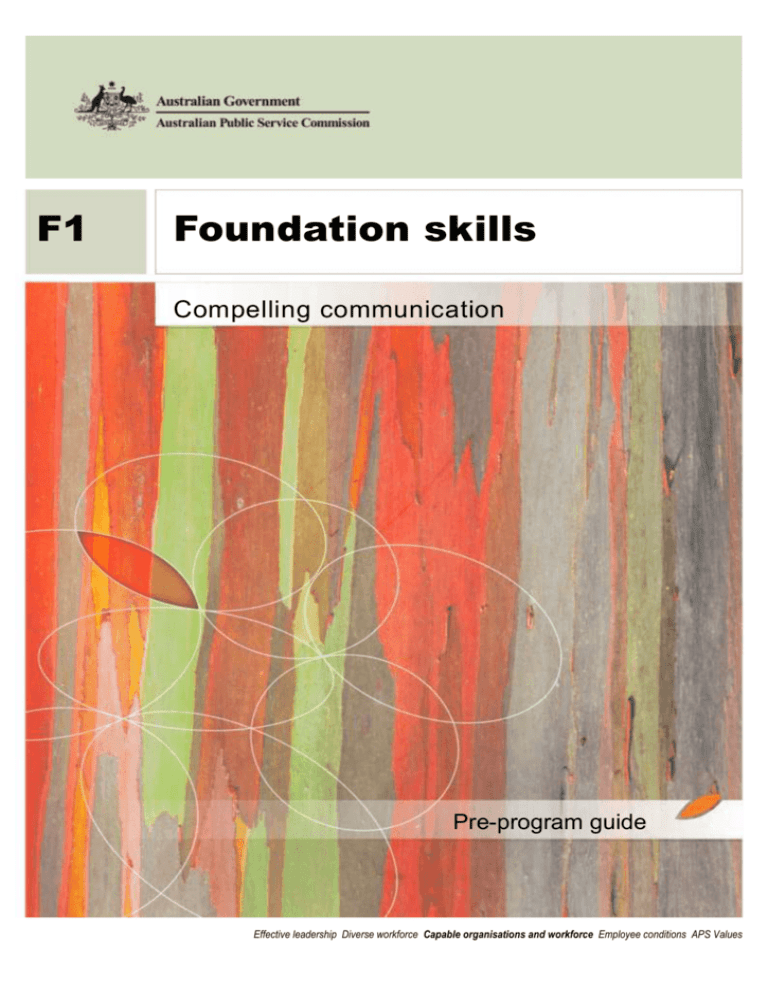
F1
Foundation skills
Compelling communication
Pre-program guide
Effective leadership Diverse workforce Capable organisations and workforce Employee conditions APS Values
Contact and acknowledgement information
Enquiries or suggestions about the learning materials are welcome and should be directed to:
coreskills@apsc.gov.au
Production team:
This learning material was developed on behalf of the Australian Public Service (APS) by the Strategic
Centre for Leadership, Learning and Development in collaboration with the APS Core Skills Reference
Group.
© Commonwealth of Australia January 2015
Except where noted otherwise, this material constitutes Commonwealth copyright administered by
the Australian Public Service Commission (Commission) on behalf of the Australian Public Service. The
Commission reserves the right to set out the terms and conditions for the use of such material.
Apart from any use as permitted under the Copyright Act 1968, all other rights are reserved.
Enquiries:
For enquiries concerning reproduction and rights in this material, please contact
communicationsunit@apsc.gov.au
Version control
Version
Date
Author
Description
1
8 January 2015
Strategic Centre for Leadership,
Learning & Development (APSC)
As released
Compelling communication
Contents
Introduction ............................................................................................................................... 4
Overview and purpose ................................................................................................................ 4
Manager or coach support .......................................................................................................... 4
The program ............................................................................................................................... 5
Program learning objectives ....................................................................................................... 5
Units and topics .......................................................................................................................... 5
Pre-program assessment ............................................................................................................ 7
Program design ........................................................................................................................... 7
Phases of the program ................................................................................................................ 8
Communication skills performance assessment ......................................................................... 9
The Compelling communication learning options ...................................................................... 9
Conducting the learning options assessment ........................................................................... 10
Personal action plan ................................................................................................................. 17
Sources and useful references .................................................................................................. 18
Introduction
Overview and purpose
Welcome to the Compelling Communication core skills program.
Compelling communication is about being able to deliver strategic and operational information
quickly and clearly to a specific target audience or individual. As such, effective communications in
the APS takes into account the needs and characteristics of specific audiences. The challenge for
public servants is that they are required to deal with many audiences, including a diverse community,
with many divergent stakeholder groups. Adding to this challenge is the need to craft
communications for busy decision-makers, both in the APS and government.
In this context, compelling communication is about providing relevant and timely information and
explaining complex policy decisions using language that is:
clear
concise
jargon-free
and ultimately
easy to understand.
The Compelling Communication program is one of four foundation public service skills and comprises
four units covering the knowledge and skill requirements in the following four areas:
1. Communication in context
2. Writing for busy APS decision-makers
3. Writing for the public
4. Spoken communication
5. APS use of social media
The program is aimed at graduate staff and new employees, as well as experienced employees
wanting to improve their skills in this area.
Manager or coach support
It is recommended that each participant completing this program works with a workplace coach to
assist with the on-the-job learning components and to achieve the program’s learning objectives.
This could be your manager or a more experienced peer. Participants are encouraged to work closely
with their coach through each phase of this program, setting goals and completing activities that
relate to the development of this skill in the context of their work. A separate guide for coaches is
provided as part of this program.
Compelling communication
| Pre-program guide
4
The program
Program learning objectives
On completion of this program you will be able to:
explain the factors affecting communication
prepare appropriate forms of written communications for APS and government decision-makers
(e.g. SES)
explain the factors involved in successful spoken word communication across a number of
contexts/situations
produce relevant, timely correspondence in a clear, understandable language that addresses the
needs of the public/communities.
Units and topics
The Compelling Communications program includes four units that cover the knowledge and skill
requirements in this area. Each unit has a number of topics and learning objectives. You will need to
complete all four units to complete the program.
Compelling communication
| Pre-program guide
5
The units, topics and unit objectives are:
Unit and topics
Objectives
1 Communication in context
List the components of communication.
1.1 Components of communication Recognise that communication is always context specific.
Describe the types of communication required in the APS and their
1.2 Recognising the context
characteristics.
1.3 Communication in the APS
Describe the characteristics of a range of typical public service
1.4 Tailoring to public service
audiences and list their communication requirements.
audiences
2 Writing for busy APS decisionmakers
Demonstrate the use of critical thinking in the scoping and planning
2.1
Critical thinking and planning
2.2
Analysis of information sources
2.3
Summarising your message
2.4
Structuring your message
2.5
Releasing the message
2.6 Using templates and tools
Recognise the diversity and needs of the community with which
3 Writing for the public
3.1 Responding to diverse
communities
3.2 Writing for the public
3.3
Choosing the right medium
the APS communicates.
Paraphrase a piece of policy or technical language into plain, easily
understood text.
Identify the appropriate medium for a particular form of
communication.
Identify the differences between forms of written and spoken
4 Spoken communication
4.1 Differences between written
and spoken communication
4.2 Turning written communication
into spoken
4.3 Formal presentations
4.4
Oral briefings and strategic
conversations
5 APS use of social media
5.1 Appropriate use of
social media
Compelling communication
of a piece of correspondence.
Distinguish appropriate sources of information and identify key
content for relevant piece of correspondence.
Demonstrate the ability to concisely summarise the key content
from an information source.
Employ a logical structure to draft a coherent, meaningful message.
Explain the processes involved in releasing communication products.
Recognise how agency templates and tools can assist with written
communication, and the advantages and disadvantages of copying
previous correspondence.
communication.
Modify a simple piece of written communication into spoken
communication.
Recognise the success factors of effective formal presentations.
Deliver an oral brief.
Employ a number of techniques to influence in strategic
conversations to achieve a specific outcome.
Discuss the principles of appropriate use of social media by APS
employees.
| Pre-program guide
6
Pre-program assessment
Before commencing the Compelling Communication program, participants should complete the
Communication Skills Performance Assessment in this guide to determine that you have the basic
level of written and spoken communication skills in order to complete this program.
Program design
This program uses an integrated learning approach based on the 70:20:10 model of learning as
illustrated in Figure 1. In line with the 70:20:10 model, the program is completed over three phases,
as outlined in Figure 2.
Figure 1: The 70:20:10 model of development
Figure 2: The Compelling communications program
Compelling communication
| Pre-program guide
7
Phases of the program
An overview of each of the phases of the program is outlined in the table below:
Phase
Overview
Pre-program
Communication skills performance assessment
With the support of your manager or coach, complete this assessment to determine your
current level of communication performance against the Australian Core Skills
Framework (ACSF) requirements (pages 10–16). The outcome of this assessment will
inform your personal development approach for this skill.
Personal learning action plan
Use this plan to map out the actions you will take to complete the formal program and
additional activities you will undertake on the job to continue the learning (page 17).
Phase 1
Compelling communications e-learning
You need to have completed this all four modules and activities of the e-learning before
attempting Phase 2.
Phase 2
2-day workshop
This phase involves coming together to develop and practise your skills in both written
and spoken communication.
Self-paced option
Depending upon the outcome of your communication skills performance assessment, you
may choose to complete this phase as a self-paced program, with guidance from your
coach or manager.
Phase 3
On-the-job learning
This phase sees you applying your communication skills in the workplace by
implementing your personal learning plan with support from your manager or workplace
coach.
Compelling communication
| Pre-program guide
8
Communication skills
performance assessment
The Australian Core Skills Framework (ACSF) was developed in 2008 and describes five levels of
performance for the five core skills of learning, reading, writing, oral communication, and numeracy.
The ACSF has been designed as a framework with applications for a range of contexts, including the
workplace. As a result, this guide uses the ACSF as a basis for you and your manager or coach to
assess your written and oral communication levels and to correspondingly select the most
appropriate learning options.
You and your manager or coach should assess your ability to complete the sample activities in the
provided ACSF Writing and Oral Skills workplace and Employment Level Sample Activities matrix (see
Table 1) as the means of identifying the written and oral communication levels at which you
currently operate.
The Compelling communication learning options
Based on these assessments, there are three recommended learning options for building your
compelling communications capabilities:
Levels 1–2 (written): attend an agency ‘basic writing’ course
Levels 1–2 (oral): consider attending a presentation, facilitation or communication skills workshop
Level 3: complete Phase 1, 2 & 3 of the Compelling communications learning program, attending
the workshop option of Phase 2.
Levels 4–5: complete Phase 1, 2 & 3 of the Compelling communications learning program. Based
on your work circumstances and learning preferences, for Phase 2, choose to either attend a
workshop or complete the activities in the Phase 2 workbook self-paced with support from your
manager or coach.
Compelling communication
| Pre-program guide
9
Figure 3: Recommendations based on ACSF levels
Figure 4: Steps to identify learning options for your communication development
Conducting the learning options assessment
Instructions for conducting the learning options assessment:
1. You should complete this assessment with your manager or coach.
2. Starting from Communication Performance level 5 in Table 1, you or your manager should place
ticks against the sample written and spoken activities that you competently perform in the
workplace.
3. Stop at the written and spoken levels where you are able to record ticks against 70-80% of the
sample activities. For example, if you are able to place ticks against 70-80% of the level 4 written
and spoken sample activities, don’t proceed to assessment against the level 3 sample activities;
your assessed level for both skills will be level 4.
4. Once you and your manager have assessed your current written and spoken levels of
performance, record the results in Table 2.
5. Based on these results, agree upon which recommended learning option is appropriate for your
level and circumstance, and then record this option in Table 2.
Compelling communication
| Pre-program guide
10
Table 1: ACSF writing and oral skills workplace and employment level sample activities matrix
SAMPLE ACTIVITIES
LEVELS OF COMMUNICATION PERFORMANCE
Written
5 Writes a position paper or report
based on analysis of data and
stakeholder consultations
Writes an organisational plan based
on task analysis, worker input and
financial data
Prepares a contract for service
delivery
Develops website content or
promotional material designed
specifically for the needs of the
audience
Writes a risk management plan for a
particular workplace, identifying
possible risks and treatments
Writes a detailed procedural text,
including alternative courses of action,
after defining the needs of the
audience and the purposes of the
information, e.g. develops work
instructions supported by graphics,
taking into account the needs of a
culturally and linguistically diverse
workforce
Defines the purposes and objectives
for the use of a particular technology,
Adapts task instructions to suit
changes in a process or technology,
e.g. writes plain English instructions
for the operation of a new machine,
based on the manufacturer's
instructions
Writes a position paper or report
based on analysis of data and
consultations conducted with a range
of stakeholders, e.g. external and
internal customer feedback on quality
of service
Designs a survey to accurately
ascertain client satisfaction levels and
presents a process to evaluate
responses
Compelling communication
Spoken
Learning
recommendation
Explains technological concepts to a
Select either:
work group unfamiliar with the
concepts involved, using visual aids
such as photos and diagrams
Leads a discussion with a focus group
to explore solutions to a complex
workplace problem
Determines stakeholder requirements
through open-ended questioning,
active listening, paraphrasing and
summarising
Expresses own values, ideas and
attributes through language choice as
appropriate to various contexts, e.g.
job interview or group discussion
Presents an explanation of a
workplace procedure to a group,
adapting, reiterating, summarising and
clarifying information as required to
facilitate maximum learning for the
audience
Leads and/or facilitates group
discussion which explores solutions to
specific problems with new
technology, e.g. implementation
issues arising from changing work
practices as a result of installation of a
new computer system
Discusses organisational or system
requirements in a conversation with a
colleague or supervisor, e.g. discusses
suitability of skills and prior
experience for an advertised position
or in-house promotion or mentors a
new colleague on the demands of the
role
Negotiates outcomes in discussions
which embrace a range of potentially
conflicting perspectives within an
organisation, e.g. changes to work
practices or formulation of a mission
statement
| Pre-program guide
Formal Compelling
Communications
program
or
Self-directed
Compelling
Communications
program
11
SAMPLE ACTIVITIES
LEVELS OF COMMUNICATION PERFORMANCE
Written
4 Prepares an induction manual or
standard operating procedures to be
used in the workplace.
Documents roles, responsibilities and
timeframes for a project plan.
Compiles a report with input from a
range of sources.
Writes clear and detailed instructions
organised sequentially, for individual
members of a group in order to
complete a group activity.
Writes organisational procedures and
time frames to take account of
different roles and perspectives.
Writes a technical/design brief or a
complex work instruction based on
client and stakeholder requirements.
Gathers information from a range of
sources and rewrites using headings,
instructions and layout that meet the
needs of the audience and purpose of
the text, e.g. job instructions or
evacuation instructions.
Writes a report on the impact of a
particular procedure or technology for
a specific audience.
Creates a range of formal texts
incorporating specific workplace
forms and language and maintains
records on a computer, e.g. memos,
letters to clients, agendas, minutes,
emails or reports.
Compelling communication
Spoken
Learning
recommendation
Provides feedback to a trainee in a
Select either:
structured setting.
Discusses causes of a problem with
co-workers and negotiates a solution.
Provides feedback to a service
provider about delivery.
Determines client and stakeholder
requirements to inform a design or
technical brief.
Presents explanation of a workplace
procedure to a group, choosing
language appropriate to the audience.
Actively participates in workplace
meetings.
Interacts effectively stakeholders to
identify and remedy problems/
complaints/disagreements.
Listens to a set of instructions
detailing changes to workplace
processes and notes key changes and
the reasons for the changes.
Follows a sustained sequence of
instructions presented orally when
using new technology, machinery,
appliance or equipment.
Facilitates team discussions and
negotiations, e.g. on suggested
changes to work practices or the
implications of workplace
mission/vision statements.
| Pre-program guide
Formal Compelling
Communications
program
or
Self-directed
Compelling
Communications
program
12
SAMPLE ACTIVITIES
LEVELS OF COMMUNICATION PERFORMANCE
Written
Spoken
3 Writes clear sequenced instructions
for using routine/everyday
technology, e.g. office equipment or
machinery.
Writes a routine report, e.g. an
accident report, an incident report, a
report on a case where repair work is
not able to be completed as
requested or a summary of a service
provided.
Completes workplace records and
forms accurately and legibly using
correct technical and enterprise
specific vocabulary.
Enters routine data into a computer
based management system.
Uses email for routine workplace
communication.
Writes a factual text, e.g. a job history
as part of a job application letter,
following organisational guidelines.
Completes a performance appraisal
review form and documents personal
goals.
Takes notes in a short discussion in
order to inform work colleagues who
were not present.
Compelling communication
Learning
recommendation
Delivers a short prepared talk to
Formal Compelling
co-workers and responds to audience Communications
questions.
program
Listens and responds to routine
customer complaints requiring
limited negotiation.
Listens to clear, sequenced
instructions of several steps, and asks
clarifying questions as required.
Questions the implications of new
processes or procedures.
Gives clear sequenced instructions of
several steps, e.g. how to use a
photocopier or how to log on or off a
computer.
Expresses an opinion regarding the
use of technology, e.g. most
appropriate use of email, mobile
phone, fax or SMS for a particular
task.
Participates in an oral exchange
requiring some negotiation, e.g.
responds to specific enquiries,
complaints or problems with clients,
customers or team members.
Canvasses a group of people for issues
and views.
| Pre-program guide
13
SAMPLE ACTIVITIES
LEVELS OF COMMUNICATION PERFORMANCE
Written
2 Records simple and routine
information from a telephone
message (e.g. takes a phone message
with name, phone number and short
message) on a form designed for this
purpose.
Writes brief systems-related texts
using an established format, e.g. a
brief workplace report, a menu, an
order form or an WHS incident report
on a standard workplace form/proforma.
Completes a range of forms requiring
routine, factual data, e.g. WHS
records, a job application, a
reimbursement form for expenses
such as use of a vehicle, or general
expenses.
Enters familiar information into a
database using familiar software.
Writes a list of tasks to be completed
by other team members.
Contributes to a short report
summarising a group response.
Writes a brief message for a fellow
team member.
Writes a brief dot-point statement
about a process/procedure decided in
a team meeting.
Compelling communication
Spoken
Learning
recommendation
Participates in straightforward face
Basic writing course
to face discussions with customers or
co-workers.
Listens to short, explicit instructions
for new work procedures and asks
questions to clarify.
Receives and passes on phone
messages.
Explains routine procedures to others,
e.g. workplace safety procedures or
fire drill.
Reports a
problem/hazard/fault/defect to a
supervisor.
Follows directions to perform a
sequence of routine tasks.
Listens for specific information in a
formal workplace meeting.
Asks questions to clarify and confirm
instructions, e.g. questions steps in a
new procedure if unsure.
Discusses with colleagues issues from
an office newsletter.
| Pre-program guide
and/or
Presentation,
facilitation or
communication
skills workshop
14
LEVELS OF COMMUNICATION PERFORMANCE
SAMPLE ACTIVITIES
1
Written
Spoken
Learning
recommendation
Writes one or two sentences or
Tells a supervisor about a
Basic Writing
Course
notes to summarise a group activity
or work process, e.g. notes key words
to record personal action resulting
from a team meeting.
Receives, opens and replies to a
simple workplace email message
using short, simple text.
Writes routine, everyday workplace
specific vocabulary and
abbreviations, e.g. product names.
Fills in details on a simple form,
e.g. an application for leave, a
payroll authority or log entry.
Uses some common symbols to fill
in a form, e.g. a tick or a cross.
Completes workplace checklists.
Sends a short SMS text to a colleague
or supervisor.
Writes contact numbers for personal
reference, e.g. an immediate
supervisor or emergency services.
problem/issue.
Listens to short announcements
and identifies key information such
as own name or department.
Expresses a personal opinion or
preference in a discussion with
co-workers.
Asks questions and follows specific
information/instructions in an
immediate environment in order to
complete a highly familiar procedure.
Describes a routine task, using
workplace specific vocabulary as
appropriate, supported by body
language, e.g. explains how to turn
on a familiar piece of machinery or
operate a piece of technology.
Listens to and responds to short,
clearly worded requests.
Gives basic facts about own personal
background in a survey at work.
and/or
Presentation,
facilitation or
communication
skills workshop
jjjllll
Compelling communication
| Pre-program guide
15
Please complete the following summary of your and your
manager’s level assessments and learning recommendations
Table 2: Communication level assessments and recommendations
Communication performance level
assessment
Recommended learning option
Written
Oral
Compelling communication
| Pre-program guide
16
Personal action plan
The learning action plan
Plan your personal approach to achieving the learning objectives of the APS Compelling
Communications program by using the table below.
Align your plan to achieve the objectives in the unit and topic table on page 7.
Learning goals
Achievements
Further
development
Post-program
OTJ actions
Pre-program
ACSF level:
Phase 1:
eLearning
Date:
Phase 2:
Date:
Phase 3:
Date:
Compelling communication
| Pre-program guide
17
Sources and useful references
Australian Government Web Guide, Social Media, viewed 16 February 2014,
http://webguide.gov.au/web-2-0/online-consultation/social-media
Commonwealth of Australia 2012, Australian Core Skills Framework, viewed 16 February,
http://www.industry.gov.au/skills/ForTrainingProviders/AustralianCoreSkillsFramework/Docume
nts/ACSF_Document.pdf
Commonwealth of Australia 2002, Style manual for authors, editors and printers, 6th edn, rev.
Snooks & Co., John Wiley & Sons Australia, Brisbane
Government of South Australia, Plain English: A good practice guide, viewed 26 August 2014,
http://www.saes.sa.gov.au/attachments/020_plain_english_guide.pdf
Compelling communication
| Pre-program guide
18

